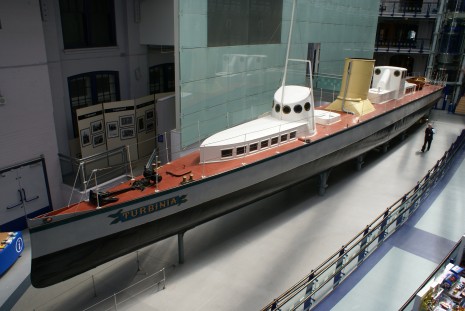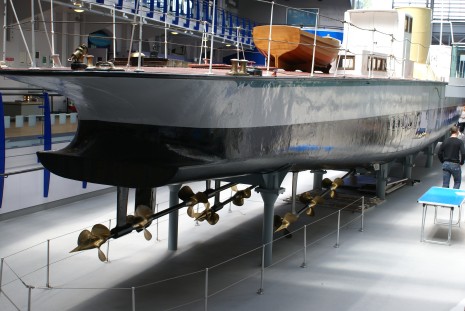| Issue 8 |
In the 1880s and 90s in Newcastle, Charles Parsons was developing the multi-stage steam turbine into the enormously important power source that it has since become. There was some extremely clever engineering involved here, but this article is concerned with his development of the first turbine-driven boat, the Turbinia. She is 100 ft long, a mere 9 ft in beam, and contains turbines that were capable of 2000 HP between them, at speeds around 2000 rpm. (I deliberately use the Imperial units in terms of which Parsons must have thought - SI units will come later!) Turbines constituted a much more compact (and also vibration-free) source of power than the reciprocating steam engines that preceded them, and Turbinia's recorded speed of over 34 knots made her the fastest ever water craft up to that time. Parsons had some serious problems getting the performance he expected, but eventually he succeeded, and then showed off his creation in 1897 by racing her at some 30 knots or more through the lines of ships assembled at the Spithead Review to celebrate Queen Victoria's Diamond Jubilee. Turbinia's influence was substantial, and by 1907 the great transatlantic liners Mauretania and Lusitania, and the Navy's Dreadnought battleships were being driven by steam turbines of far greater power.
But by 1908, Turbinia's pioneering mission was completed, and she was brought ashore and just left to rot. In 1926 her stern half with the turbines was taken down to the Science Museum in London. In the 1960s the two parts were welded together again and restored, and some 20-30 years ago I remember seeing her locked up in a shed in the Exhibition Park, Newcastle, visible only through the windows. But a year or so ago our immediate Past-President, Brian Cook, told me she was now on display in the Discovery Museum in central Newcastle, and I have recently taken an opportunity to go and see her. She has pride of place on the ground floor near the entrance (Figure 1) and is a most impressive sight. But the Museum is obviously aimed mainly at children, and since Turbinia neither moves nor makes a noise, nor can you get inside her, most of the young visitors seem to walk past without noticing her. Along one stretch of the after-hull, the steel plating has been replaced by transparent plastic, so you can see inside. This could usefully be extended, and you could see a lot better if there were some inside lighting. The internal space here is extremely congested with machinery, so you can see why they don't let casual visitors aboard. Maybe specialised pre-booked parties get a chance! There are some interesting displays alongside, particularly of some of the models he used when developing her hull shape, including one with a geared propeller driven by a twisted rubber band.

|
| Figure 1: Turbinia |
It was said earlier that Parsons had serious problems getting the performance he expected. He made a torque-meter and verified that the turbines could produce the predicted shaft power, so the fault was apparently with the propellers. So he made the first-ever cavitation tunnel to study them, and found that cavitation was indeed what he was getting. He eventually fitted nine propellers, three on each of three shafts (Figure 2), and this solved the problem.

|
| Figure 2: Turbinia's array of propellers |
The origin of the difficulty seems to have been that his turbines had no reduction gearing, perhaps because there was then no experience of making gearboxes to handle that power at that sort of speed. 2000 rpm was not a speed of which most Victorian engineers had any experience. Parsons himself later developed such gears for some subsequent vessels, and thereby solved the problem. Tests on Turbinia eventually showed that she did 32¾ knots (16.9 m/s), with the centre turbine and propeller shaft rotating at 2230 rpm (37.2 rev/s). Dividing one number by the other gives the propeller's "advance per revolution" as 0.454 m/rev. For efficient propeller design, the advance per revolution has to be not too different from the diameter, and in fact the nine propellers eventually fitted have a diameter of 18 inches (0.457 m), almost exactly the same. The area of a disc of that diameter is 0.164 m2, and the total area of the three blades somewhat less, maybe 0.1 m2.
But the force needed to propel Turbinia at this speed was probably around 50 kN. To get this force from one such propeller would thus need a pressure difference across the blades of at least 500 kPa. It is now known that more than half of this pressure difference arises from a pressure reduction on the front face. But the total static pressure in the water only a metre or so below the surface is little above the atmospheric, 100 kPa. So using only one such propeller relies on a very large negative absolute pressure! Even with three of them it is still pretty marginal. Geared-down turbines would have permitted bigger propellers, for which there was certainly room (Figure 2). But by using nine small ones, the pressure difference across the blades will come down to something like 60 kPa, and there begins to be some hope. He had already got his turbines to work by dividing the pressure drop from boiler to condenser into lots of little drops across many successive turbine wheels, and presumably realised he had to do the same thing with his propellers.
It is splendid that this remarkable vessel is now on public display, and indeed has been since 1995. Go and see her if you get a chance.
| << Previous article | Contents | Next article >> |
| SOUE News Home |
Copyright © 2009 Society of Oxford University Engineers |
SOUE Home |